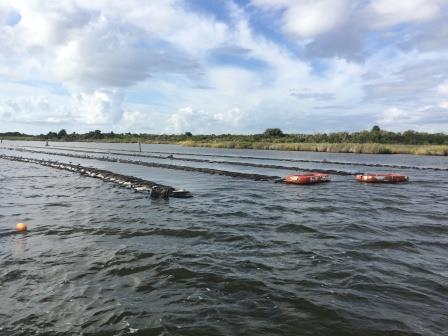Posted Oct. 6, 2015
Brady Blackburn is in his junior year at the University of North Carolina at Chapel Hill. He is majoring in environmental studies and focusing on science communication.
Carbon sequestration, pollution filtration, habitat provision and much more can be provided by one thing. And it’s not the latest state-of-the-art technology, as I would have thought. It’s the oyster.

My class is comparing the ecosystem services offered by the Bodie Island Oysters aquaculture operation to undeveloped and wild sites, all located in the Roanoke Sound. Photo by Brady Blackburn
Recently, I moved to the coast for the autumn 2015 semester, after having lived in the mountains of Western North Carolina all my life. I had no idea that these filter feeders are environmental powerhouses. Historically, wild oyster reefs quickly were decimated because of overharvesting. However, their ecosystem services are attracting more attention these days, including from the N.C. General Assembly.
I am one of 10 undergraduate students from the University of North Carolina at Chapel Hill studying at an environmental science field site in Manteo, N.C., this fall. Along with in-class environmental science courses and internships, we are working on a research project examining the effects of oyster aquaculture on the surrounding environment.
We are looking to discover if oyster aquaculture — facilitated growth of these shellfish — can provide the same types of environmental services as wild oysters do.
Oyster aquaculture, unlike many other kinds of fish and shellfish farming, consists of operations that are relatively low-tech in comparison to their counterparts.
Cages or bags filled with oysters are installed directly in bodies of water, either resting on the bottom or suspended in the water column. Water and nutrients can flow freely through the hardware.
We are studying the Bodie Island Oysters aquaculture facility, run by Joey Daniels. His facility is located in the Roanoke Sound, part of the Albemarle-Pamlico Estuarine System on the Outer Banks of North Carolina.
This unique environment is characterized by the mixing of fresh river water and salty ocean water. The lower salinity, water temperatures of around 25 degrees Celsius (about 77 degrees Fahrenheit), and shallow depth make the sound prime territory for oysters to grow.
To compare the services provided by farmed oysters to those of wild oysters, my classmates and I will examine a range of qualitative and quantitative factors.
We are measuring and comparing water quality and submerged aquatic vegetation coverage at three sites in the Roanoke Sound — the Bodie Island Oysters facility, a similar but undeveloped control site, and a wild oyster reef. Along with this study, we also are going to measure how well farmed oysters filter water compared to wild oysters in a controlled lab setting.
To complement our natural sciences research, we also will be interviewing members of the local community throughout the semester to understand their perceptions of oyster aquaculture.
We already have gathered preliminary data from the three study sites and completed the first round of interviews. I will be posting updates throughout the semester as we start crunching the numbers and putting the pieces together.